Aquaponics is gaining popularity as more and more people look for sustainable, eco-friendly ways to grow food. A small DIY aquaponics system is a fun, easy way for beginners to grow fish and vegetables and does not require a lot of space.
In this beginner’s guide, you will learn what aquaponics is and how it works. We also explore how it compares to other growing methods, the pros and cons, and how it relates to permaculture.
You will learn what plants and animals you can grow in an aquaponics system, the different growing methods used and how to build a media-based DIY aquaponics system.
What is Aquaponics?
Aquaponics is a sustainable growing technique that combines elements of both hydroponics and aquaculture in one integrated system.
The name is also a combination of the two, with the “aqua” from aquaculture, the breeding of aquatic animals in tanks, and the “ponics“ from hydroponics, the cultivation of plants in water without soil.
Aquaponics is an environmentally friendly way to produce fish and plants simultaneously in a closed loop system.
Aquaponics systems can be set up indoors or outdoors on a small or large scale. Smaller aquaponics systems are space saving and a good option for urban farmers producing a constant supply of fresh vegetables and fish.
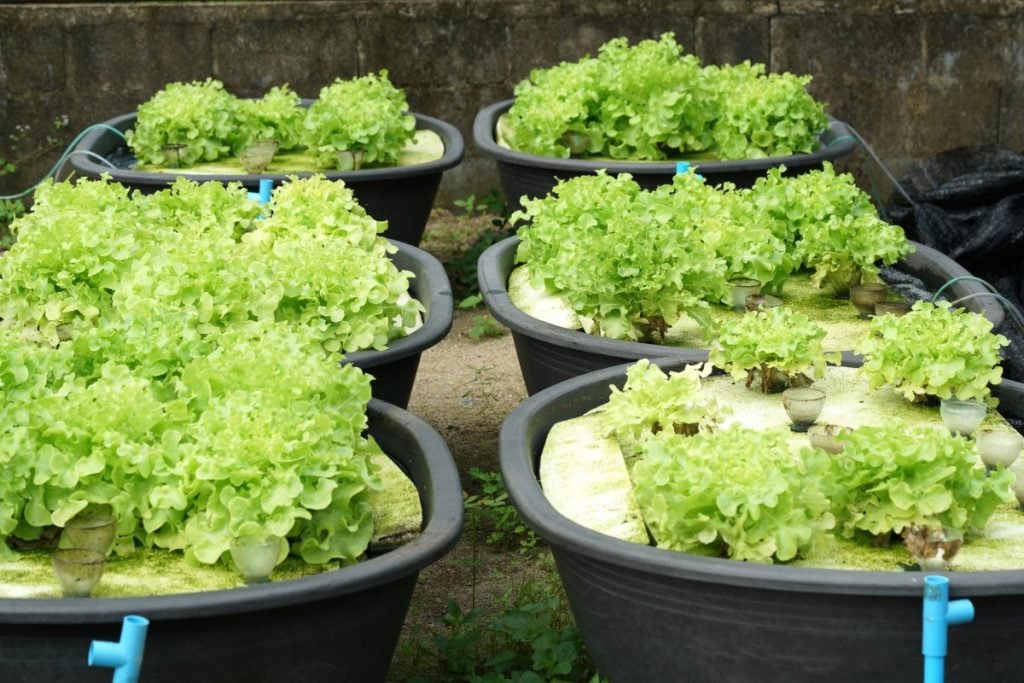
What is the point of aquaponics?
The point of aquaponics is to produce plants and fish in a sustainable, eco-friendly way with minimal waste.
Aquaponics mimics a natural ecosystem and harnesses the relationships between plants, bacteria and aquatic life that are found in natural waterways.
How Does Aquaponics Work?
In an aquaponics system the fish and bacteria provide nutrients for the plants and the plants filter the water for the fish. It is a closed loop system that recycles water and minimizes waste.
Here’s how an aquaponics system works.
- The fish eat food you provide and produce ammonia rich waste.
- Water with fish waste is pumped to the grow bed, a container providing a place for the plants to grow.
- In the grow bed, bacteria convert the fish waste (ammonia and nitrites) into fertilizer (nitrates) for the plants.
- The plants use the nitrates for growth and to purify the water.
- The clean water is returned to the fish tank and the cycle repeats itself.
The Basic Components of an Aquaponics System
No matter what size your aquaponics system or which growing method you choose, they all need the following basic components.
- A fish tank
- Pumps and hardware
- Grow beds
- Fish
- Plants
- Bacteria
- Light
Why is PH in Aquaponics so Important?
Successfully managing the pH level of the water in your aquaponics system is critical for success and can be challenging.
The reason for this is that the living components of the system, fish, bacteria and plants, all have their own ideal pH range.
When the pH level of the water is incorrect, it could lead to underperforming plants, unhealthy fish and in extreme cases may even kill the bacteria, fish or plants.
Most plants prefer slightly more acidic pH levels, while bacteria and fish prefer slightly alkaline pH levels. To balance the needs of your plants, fish, and bacteria you should aim for a neutral pH range.
The ideal pH range for an aquaponics system is between 6.8 and 7.2. Maintaining the pH in this range will keep the bacteria happy and working at full capacity and provide the plants with full access to all the nutrients they need to grow well.
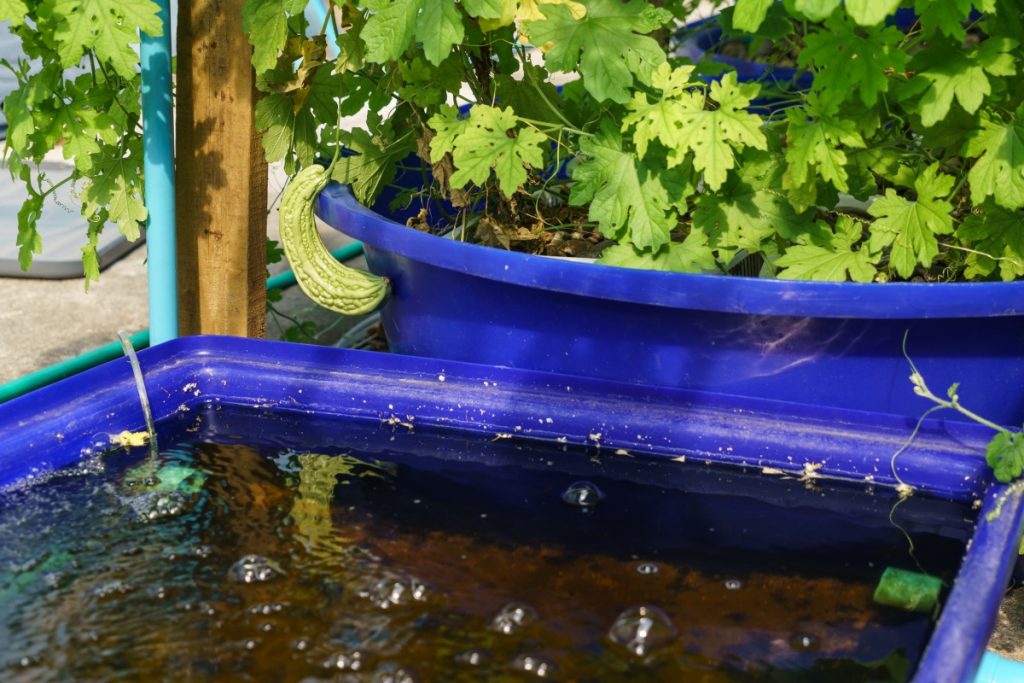
Aquaponics Compared to Other Growing Methods
Aquaponics systems enhance the benefits and reduce the drawbacks of aquaculture and hydroponic systems.
Let’s take a look at how aquaponics compares to other techniques used to grow plants and aquatic animals.
Aquaponics vs. Traditional Soil Gardening
Soil can be a rich fertile medium that provides a wide range of nutrients for plants.
However, maintaining traditional soil gardens can be very time-consuming, and creating good, nutritious soil for your plants can take months.
| Traditional Soil Gardening | Aquaponics |
| Soil quality is not always ideal, and growers may encounter nutrient deficient clay, sandy or rocky soil. Many urban locations have no soil access and will need raised beds to grow plants. | Aquaponics systems don’t use soil for nutrients. |
| Soil loses fertility over time and needs replenishing with compost or fertilizer. | The fish and bacteria provide a constant supply of nutrients for the plants. |
| Removing weeds and managing pests, insects and diseases can be time-consuming and require harmful chemicals. | Indoor aquaponics systems reduce weeds and pests. |
| Plants growing in soil need to be watered often and correctly and can be over or underwatered. | By constantly recycling nutrient-rich water, aquaponics uses substantially less water than any other system. |
| Traditional soil gardening requires a certain amount of physical labor including, digging, bending and carrying. | Waist height aquaponics systems eliminate bending, and no digging is required. |
| Small gardens may be in backyards or on patios. However, large operations require space, resulting in locations far from the end-user with expensive packaging, transportation and refrigeration costs. | Aquaponics systems are scalable and do not require access to earth, making them easy to assemble in urban areas close to end-users. |
Aquaponics vs. Hydroponics
Hydroponics is a method of growing plants without soil. In a hydroponic system, plants are grown in an inert growing medium and fed water-based nutrient-rich solutions.
Hydroponics solves many soil-based problems but also has a few challenges.
| Hydroponics | Aquaponics |
| Hydroponic systems rely on expensive, nutrient-rich solutions to feed the plants. | Aquaponic systems require food for the fish. |
| You need to monitor a hydroponic solution’s strength on an ongoing basis, as well as the pH and total dissolved solids. | Once established, the pH and ammonia levels in an aquaponics system only need to be checked weekly or if fish or plants look unwell. |
| Over time, salts and chemicals build up in the water, making it toxic for plants. The water then needs to be replaced and the wastewater disposed of in a suitable location. | The water in aquaponics systems does not need replacing and only needs to be topped up as it evaporates. |
Aquaponics vs. Aquaculture
Aquaculture is the farming of fish and other aquatic animals in a controlled environment. Many fish farms use recirculating aquaculture systems which filter and re-use as much water as possible.
| Aquaculture | Aquaponics |
| In aquaculture, one of the most significant expenses is filtering the tank water to remove fish waste. | Plants filter the water in an aquaponics system. |
| Aquaculture uses a lot of water and may need up to 20 percent of the water in a tank replaced daily. | The water in aquaponics systems does not need replacing. |
| In unhealthy aquaculture systems, fish diseases are common, and fish often need preventative medicine. | Fish diseases are rare in aquaponics systems. |
Aquaponics as Part of Permaculture
Aquaponics mimics natural ecosystems, does not use pesticides or harsh chemicals, and recycles water.
Many people feel it has a place as part of a permaculture design and fits in with the 12 permaculture principles. But not everyone agrees.
There are persuasive arguments for aquaponics when assessed against most permaculture principles. However, there is debate around whether it uses renewable resources for the required inputs or not.
When creating a DIY aquaponics system, you can address many of these issues. For example, building the components with recyclable or recycled materials and using solar or wind energy to power the pump.
Sourcing or growing sustainable fish food and using low impact growing media in an aquaponics system increases its sustainability and further reduces environmental impact.
Depending on the circumstances, aquaponics may or may not be the right system for you. It has a high yield but is an intensive, zone-one way of producing food due to the ongoing monitoring and input required.
On permaculture farms with lots of space, other aquatic systems may be better. But in urban areas and suburban backyards, where space and soil are in short supply and electricity is cheaper, it is an excellent option.
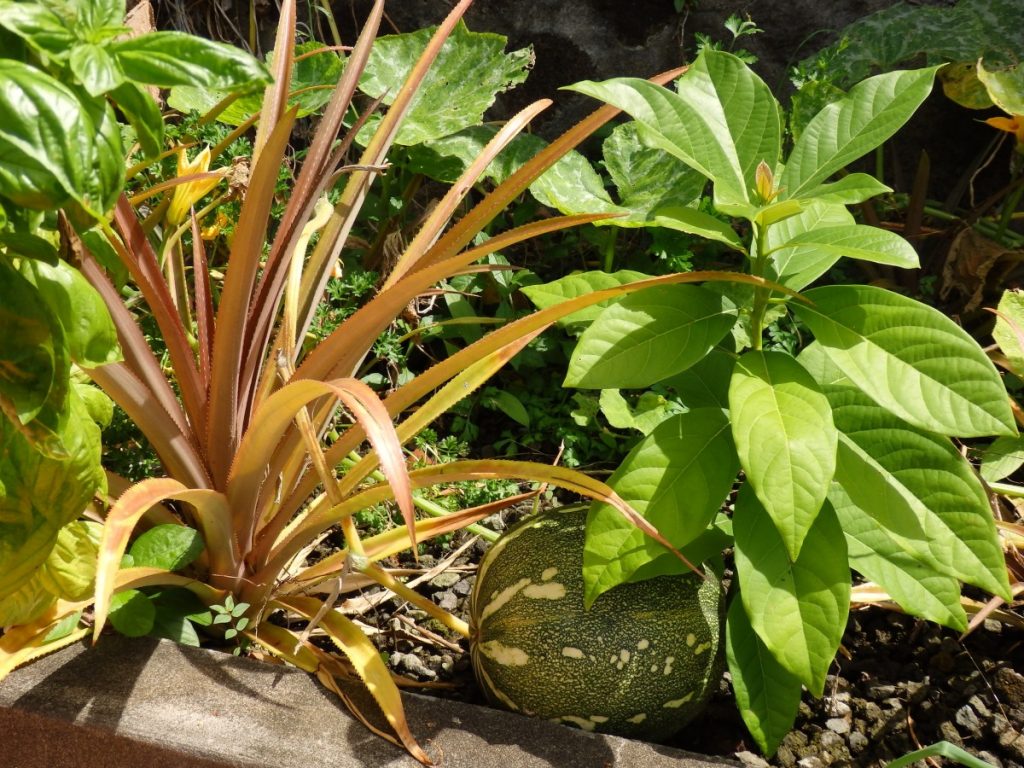
What Can You Grow in Aquaponics?
You can grow most plants in an aquaponics system, but the size of your aquaponics system will dictate the best plants to grow.
Smaller systems, with fewer fish, have less waste and lower nutrient concentrations. Larger systems, on the other hand, have more fish and higher nutrient concentrations.
Below we look at some of the best types of plants you can grow in an aquaponics system.
1. Leafy greens
Leafy green vegetables have low nutrient needs and are ideal for any size system. They are an excellent choice for beginners as they grow well in small and newly built aquaponics systems.
These leafy greens are full of goodness and easy to grow:
- Lettuce
- Kale
- Spinach
- Swiss Chard
- Arugula
- Bok Choy (Pak Choi)
2. Herbs
Herbs, like leafy greens, have low nutrient requirements and are ideal for small aquaponics systems. They are versatile and used for both medicinal and culinary purposes.
These easy to grow herbs have distinct aromas and flavors and numerous uses.
- Mint
- Basil
- Cilantro (Coriander)
- Parsley
- Oregano
- Rosemary
- Thyme

3. Microgreens
Microgreens are an ideal crop for an aquaponics system and can be grown from seed to harvest in under 14 days, providing healthy greens year-round and a profitable crop.
They have low nutrient requirements and are easy and rewarding to grow in small systems.
A wide range of vegetables and herbs can be grown as microgreens. Here are some of the best ones for beginners.
- Alfalfa
- Clover
- Collards
- Kale
- Kohlrabi
- Radish
- Broccoli
- Arugula
- Watercress
- Pea shoots
- Mustard
4. Vegetables
Vegetables are tasty, profitable plants that grow well in aquaponics systems. However, they require lots of nutrients and thus need larger systems to grow successfully.
Here are some popular vegetables that grow well in aquaponics systems.
- Tomatoes
- Peppers
- Cucumbers
- Beans
- Squash
- Peas
- Broccoli
- Cabbage
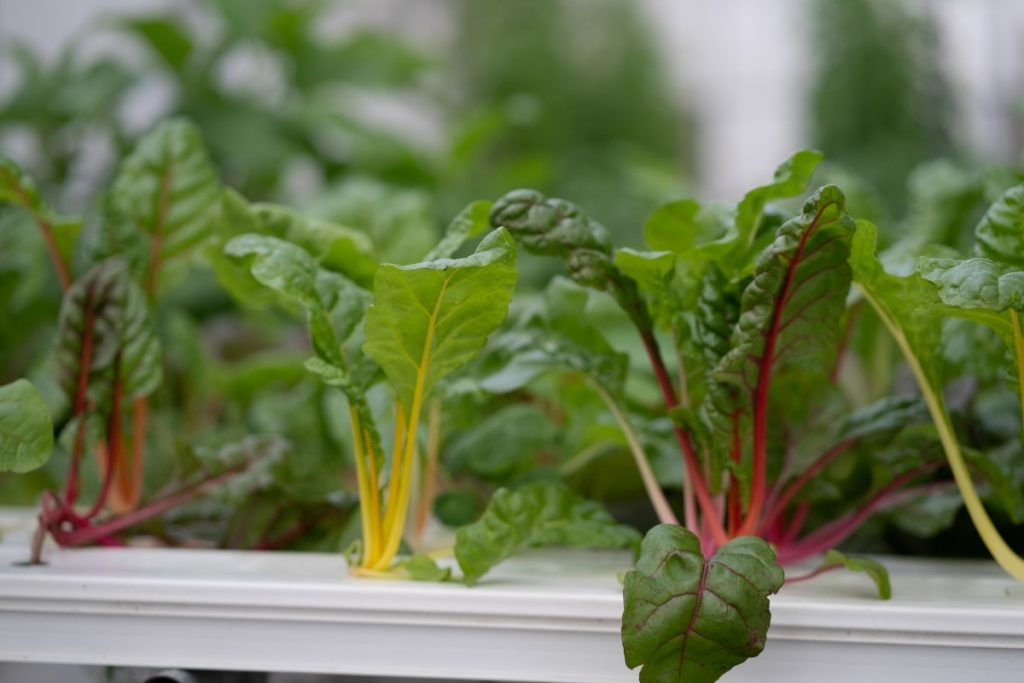
5. Fruiting plants
Fruiting plants have medium to high nutrient requirements making them a good option for larger aquaponics systems.
Homegrown fruit is not only tasty but filled with vitamins and well worth trying in your aquaponics system if you can.
Here are some fruiting plants that are relatively easy to grow in aquaponics systems.
- Strawberries
- Dwarf Citrus Trees
- Dwarf Pomegranate Trees
- Bananas
- Melons
- Pineapples
6. Flowers
Growing flowers can be an easy and fun choice for your aquaponics system. You can sell the plants, produce cut flowers for decorative purposes or sell edible flowers.
Here are some of the best flowers to try in your aquaponics system
- Marigolds
- Roses
- Nasturtiums
- Pansies
- Sunflowers
- Tulips
- Water hyacinths
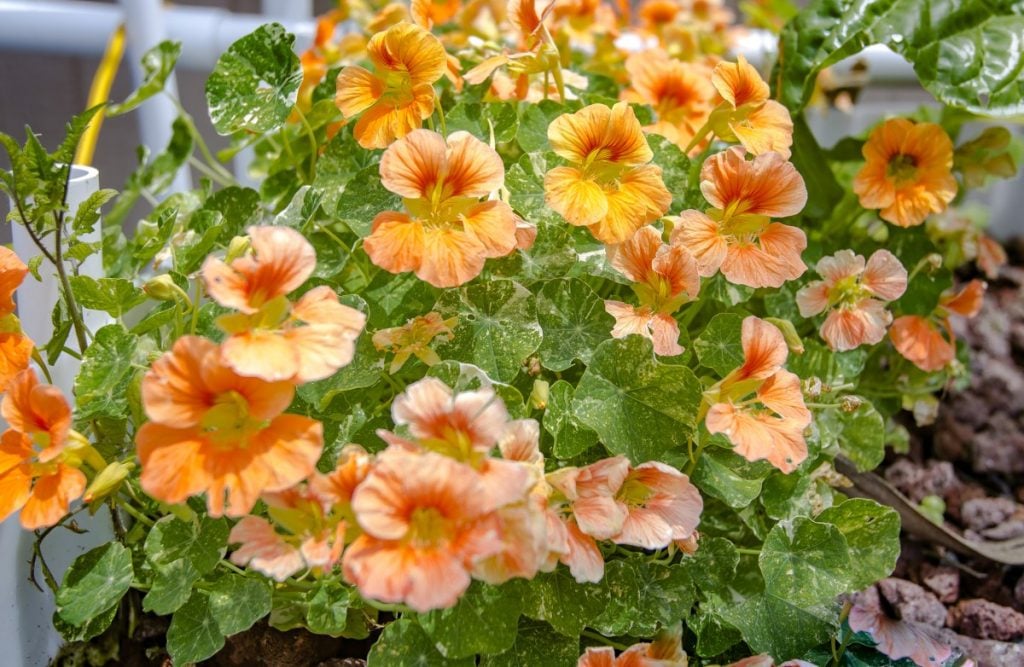
What Aquatic Animals Can You Have in an Aquaponics System?
Fish are the most common aquatic animals used in aquaponics but not the only option.
You can use other aquatic animals as long as they create waste that provides nutrients for the plants.
Here are some aquatic animals that can be used as alternatives or together with fish in an aquaponics system.
- Aquatic turtles are hardier than fish, thrive in aquaponics systems, and create more waste than fish providing lots of nutrients. However, they can carry salmonella if not cared for correctly, and we recommended using them in systems without edible plants.
- Yabbies are freshwater crustaceans that do well in aquaponics systems as they don’t need a lot of water and will eat just about anything. They come in various colors and are ready to eat in under a year.
- Freshwater shrimp or prawns eat leftovers, are easy to breed, and a great source of fish food. There is also a good market for them, making them profitable additions to any aquaculture system. Shrimps and prawns do not produce a lot of waste and need to be used together with fish in an aquaponics system.
- Mussels can filter and clean the water in aquaponics systems. However, too many can be detrimental to the system. It is best to use them occasionally and harvest them as soon as they are ready.
Now that you have an idea of what alternatives are available. Let’s look at some of the best fish for an aquaponics system.
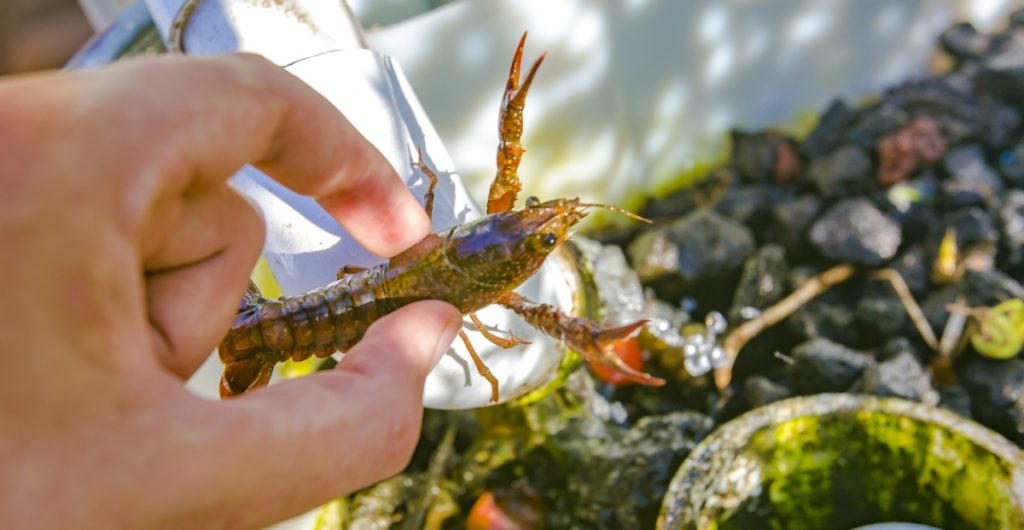
Best Fish for Aquaponics
The fish and plants in your aquaponics system should have similar temperature and pH needs. They will never be the same, but the closer the match, the more successful your system will be.
Here are some suggestions for the best fish to include in your system as a beginner:
- Tilapia are considered one of the best fish for aquaponics systems as they are hardy, easy to care for and quick growing. Large-scale commercial aquaponics operations often grow tilapia together with leafy greens.
- Bluegill are another hardy breed that does well in aquaponics systems. They are native to North America and grow to plate size in a year.
- Catfish are very adaptable fish that can survive in harsh polluted environments, making them ideal for beginner aquaponics. They are also tasty to eat and grow to edible size in under 18 months.
- Koi are part of the carp species and an ornamental fish that can grow very large. You can mix koi fish with edible fish, as long as there is enough space and no fighting. Koi are one of the hardiest fish alive as they are resistant to most parasites and tolerate a wide range of temperatures.
- Fancy goldfish are another ornamental fish that are easy to take care of and survive in polluted water. Goldfish are widely available, produce waste quickly, and are inexpensive, making them perfect for beginners starting their first aquaponics system.
Where to Buy Fish for Aquaponics
Believe it or not, it is possible to buy live fish online and have them shipped to your door.
However, make sure you use a reputable vendor, recommended by other customers, that offers a guarantee their fish will arrive alive.
Expedited shipping is also a factor, and you need to make sure someone is home to receive the fish when they arrive.
To buy local fish, you can search online for live fish suppliers in your country. However, it is also possible to ship live fish internationally.
For years ornamental fish have been successfully shipped using air freight. Today, aquaculture products such as eggs, fry and fingerlings are also shipped this way.
Live fish can be transported almost anywhere in the world and arrive in a healthy condition.
Buying fish online is not the only way to get fish for your aquaponics system.
You can also contact fish hatcheries in your area and purchase fingerlings from them, or get in touch with other aquaponics farmers near you and buy some of their surplus fish.
Buying fish locally is beneficial as you know they are already well adapted to the local climate and you can often get advice on behaviour and feeding from the farmers.
If you are planning on using ornamental goldfish or koi fish in your system you should be able to buy these at pet and garden stores in your area.
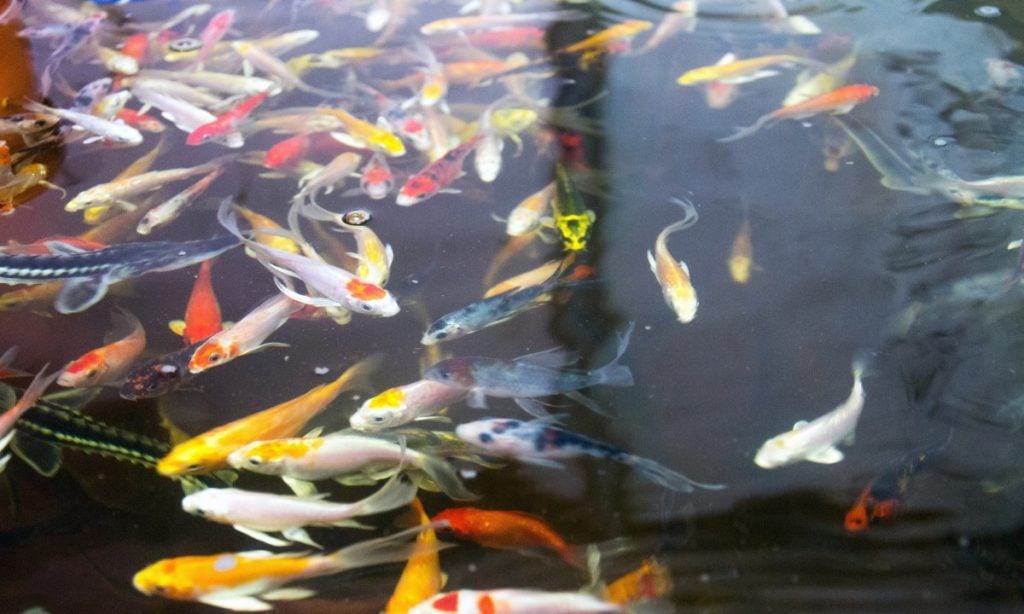
8 Factors to Consider When Choosing Fish for Aquaponics
Getting the right fish for your system and requirements helps to ensure success. Here are eight things to consider when choosing your aquaponics fish.
- Temperature preference – One of the first things you should consider is if the fish you are planning to raise can survive the temperature range in your location. If not, you are going to have to heat or cool the water for them to thrive. Knowing the temperature range in your area and the preference of the fish will help when choosing the best fish for your aquaponics system.
- Local availability – Another thing to consider is the availability of fish in your location. Using local fish or popular fish readily available in your area makes acquiring fingerlings much easier.
- Are they legal – It is illegal to purchase and grow certain fish in some areas. Before deciding on a fish for your aquaponics system, check your local fish farming laws to ensure the fish you intend to use is legal.
- Maintenance requirements – Some fish are hardy and adaptable and need little care. Sensitive fish, on the other hand, are time-consuming and costly to raise. Hardy, resilient fish are often immune to parasites and diseases and an excellent choice for beginners in aquaponics.
- Diet requirements – You need to consider the diet requirements of the fish in your aquaponics system. Some diets will affect the maintenance costs and sustainability of your system. Fish are classified based on their feeding patterns and are carnivores, herbivores, omnivores or detritivores.
- Space requirements – It is beneficial to know the adult size of the fish you want to raise and how much space they need. The size of your fish tank will determine what type of fish are suitable and how many you can have. Some fish need more space than others to thrive.
- System filtration capacity – The filtration capacity of your aquaponics grow bed will also dictate what type and quantity of fish you can keep. Your system needs to be balanced to ensure optimal growing conditions for both the fish and the plants.
- Breeding habits – You should also consider fish breeding habits when selecting fish for your aquaponics system. Some fish don’t reproduce in captivity, while others reproduce quickly and may cause fish density problems.
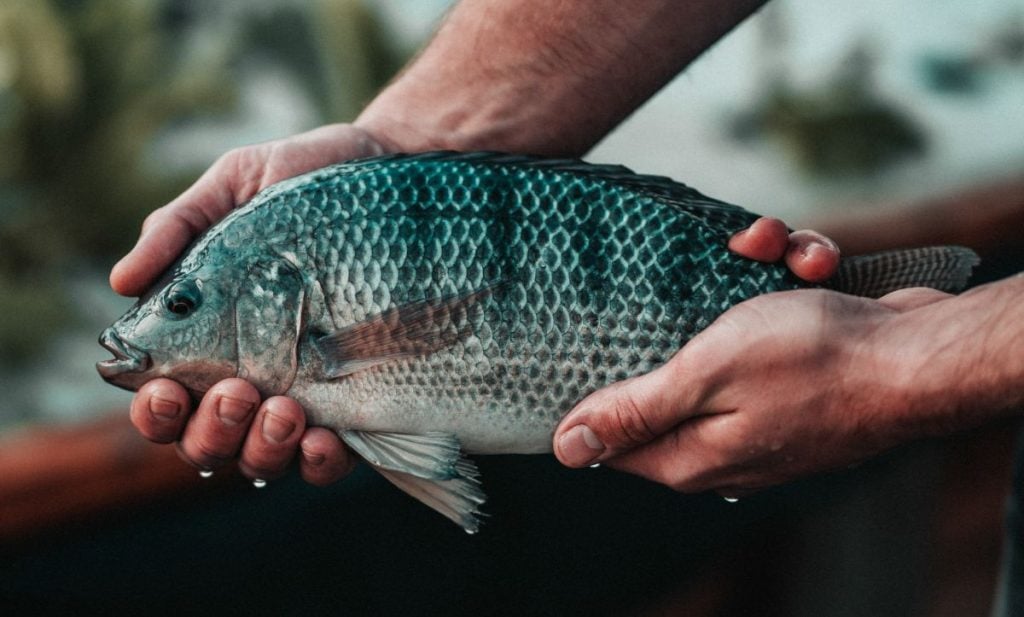
Methods of Aquaponic Growing
You can configure aquaponic systems in various different ways, but they all have a fish tank and a soil-free growing bed.
The filtration and plumbing components, type of plant bed, amount of water, and frequency of water circulation and aeration vary depending on the method chosen.
There are three primary aquaponic methods used, all based on a hydroponic system design, with adaptations for fish or aquatic animals and filtration.
1. Nutrient Film Technique (NFT)
Nutrient film technique (NFT) is a growing method in which plants are grown in long narrow channels made from gutters or PVC pipes with holes cut in them.
The plant’s roots dangle through the holes into the channels where they draw nutrients from the water. A continuous, thin film of water flows down the channel, providing a constant supply of nutrients and oxygen.
This aquaponics method is best for plants with a small root mass that don’t need support to grow, like leafy greens. Larger fruiting plants are often too heavy, and their roots may clog the channel.
These systems can be set up horizontally or vertically and are ideal for small spaces.
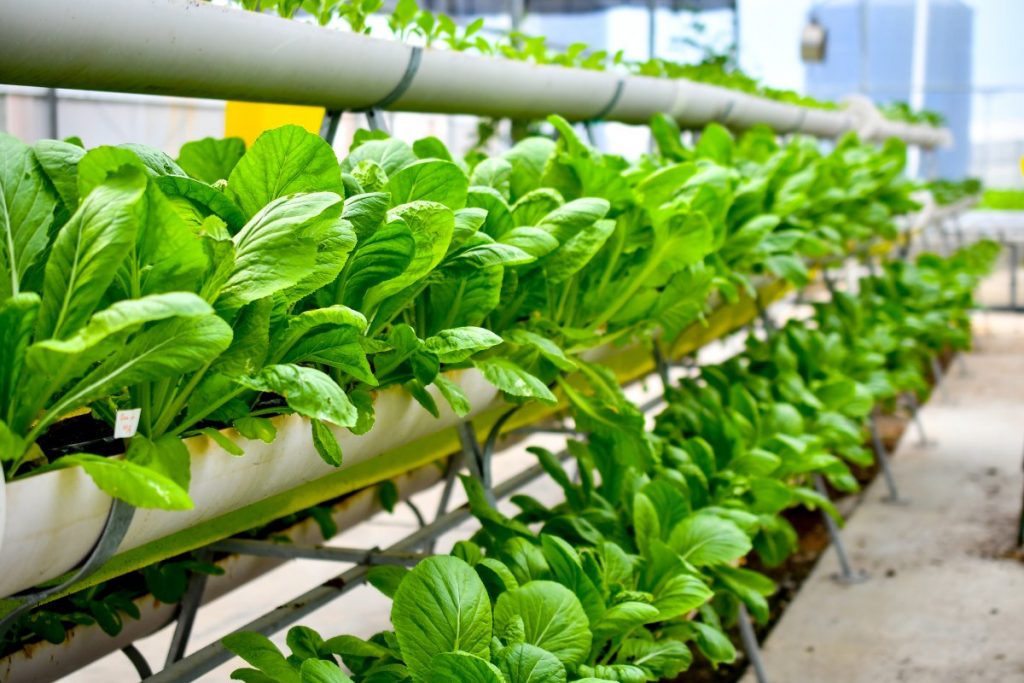
2. Deep Water Culture (DWC)
The deep water culture method, also known as the raft or float method, uses floating rafts with holes to suspend plant roots into nutrient-rich, aerated water.
The rafts, usually styrofoam or polystyrene, float in grow beds that hold a pool of water around 1 foot (30.48 cm) in depth. Net grow bags filled with clay or coconut growing medium can be placed in the holes to hold plant substrate.
Commercial operations use this system most as the initial setup can be more expensive due to the large grow beds and additional filtration required. However, the system is easy to scale and ideal for large, high-yield operations.
The deep water culture system is the most stable as it has more water, reducing potential water problems. A raft can support larger root zone plants than NFT.
Other advantages are the fact that removing plants is easy, and the rafts are reusable.

3. Media-based Aquaponics
In media-based aquaponics systems, plants are grown in containers filled with growing media that supports their roots. Water pumped from the fish tank periodically floods the grow beds and provides the plants with nutrients.
All the waste from the fish tank breaks down within the plant bed, and the filtered water drains back to the fish tank.
The media not only supports the plants. It also acts as a mechanical and bio-filter to capture and break down the fish waste.
Media beds can support plants with a large root mass like fruits, flowering plants, vegetables, and root vegetables. Often the growing beds are located above the fish tank in a vertical design, saving space.
The media bed technique is the best method for backyard gardeners and beginners. It is inexpensive, simple to set up, needs no additional filtration and is very productive on a small scale.
In the next section, you will discover how to build up a media-based DIY aquaponics system step by step.
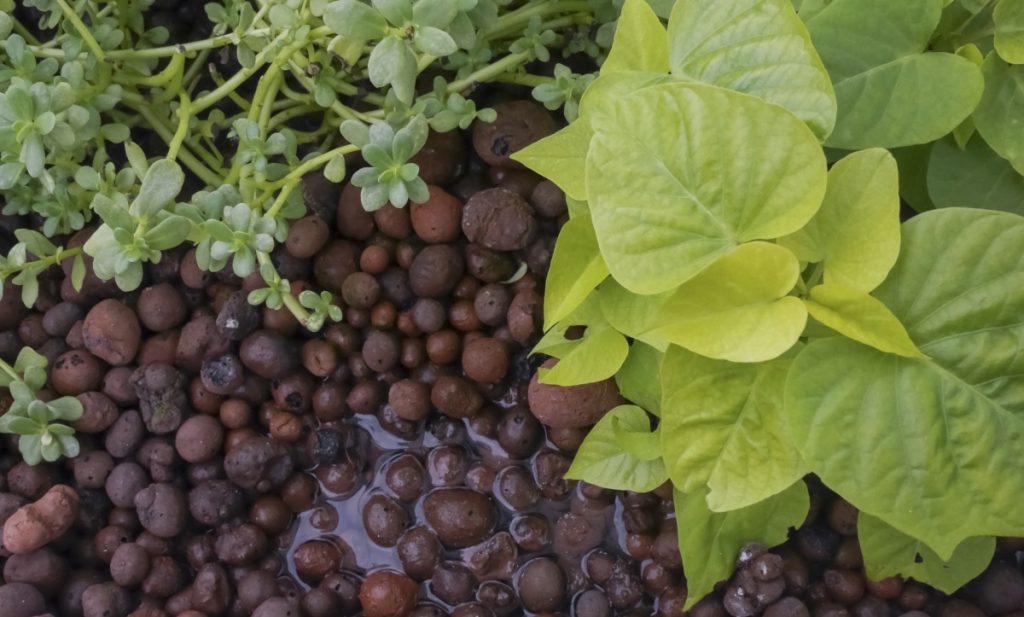
How to Build an Aquaponics System – Step by Step
Large, ready-made aquaponics systems can be expensive to buy. Although there are smaller kits available, building a DIY aquaponics system can be extremely rewarding.
Creating a DIY aquaponics system from scratch requires planning and takes time. However, it is more affordable and allows you to customize the system to suit your space and requirements.
You can also recycle objects and select eco-friendly materials when constructing a DIY aquaponics system.
Use the steps below to set up a media-based aquaponics system at home and grow fresh vegetables and fish.
Step 1: Find a location
Before you begin building, you need to decide on a location for your aquaponics system. If you plan to use your aquaponics system to grow and sell fresh produce, you will need a larger system and more space.
An aquaponics system may be located indoors, outdoors or in a greenhouse. Consider the climate in your area and your surroundings when deciding on a location.
If you live in an urban high rise, you can set the system up indoors, with artificial or window lighting.
If you live in an area with a suitable climate, you can grow aquaponics produce outdoors in a flat, sunny location all year round. However, If you have cold winters, you may need to move your system indoors or put it in a greenhouse.
Aquaponics systems need monitoring, so it is a good idea to install them nearby and not in the farthest corner of your property.
Unless you are using solar power, you need electricity nearby to run the pump and a water source for filling and occasionally topping up the tank.

Step 2: Set up your fish tank
The size of your system and the type of fish you decide to keep will determine the size of the tank you need.
Many people use large opaque barrels or square bins recycled from the food industry. But old baths, metal watering troughs or wooden structures with pond liners all work well.
Place the tank in the location you have chosen. If you use a barrel, you need to cut the top open to allow for oxidation and build a stand to prevent it from rolling over.
Step 3: Create your growing bed
A growing bed is a waterproof container of some sort holding the soilless medium that supports the plants. You can install your growing bed, sometimes called a flood table, above or alongside the fish tank.
You can purchase ready-made growing bed containers, use large heavy-duty plastic trays or adapt wooden pallet crates.
However, building shallow wooden grow beds six to ten inches ( 15 to 25 cm) deep, similar to raised beds, is a simple and cost-effective solution.
When your boxes are complete, they need to be lined with a pond liner and mounted on a stand that can withstand their weight when full of media and water.
It is important to remember to mount the beds at an angle of around five degrees, not flat. Enough to allow the water to flow through the media bed and back into the fish tank.
You also need to make a hole in the lower end of the growing bed for the PVC pipe to take the water back to the fish tank.
Once mounted, fill the grow bed with your choice of growing medium. Perlite is light making it easier to elevate the grow beds, while gravel can be heavy but is inexpensive.
Clay pebbles are pH neutral, hold moisture well and have a large surface area for the bacteria, making them a popular choice.
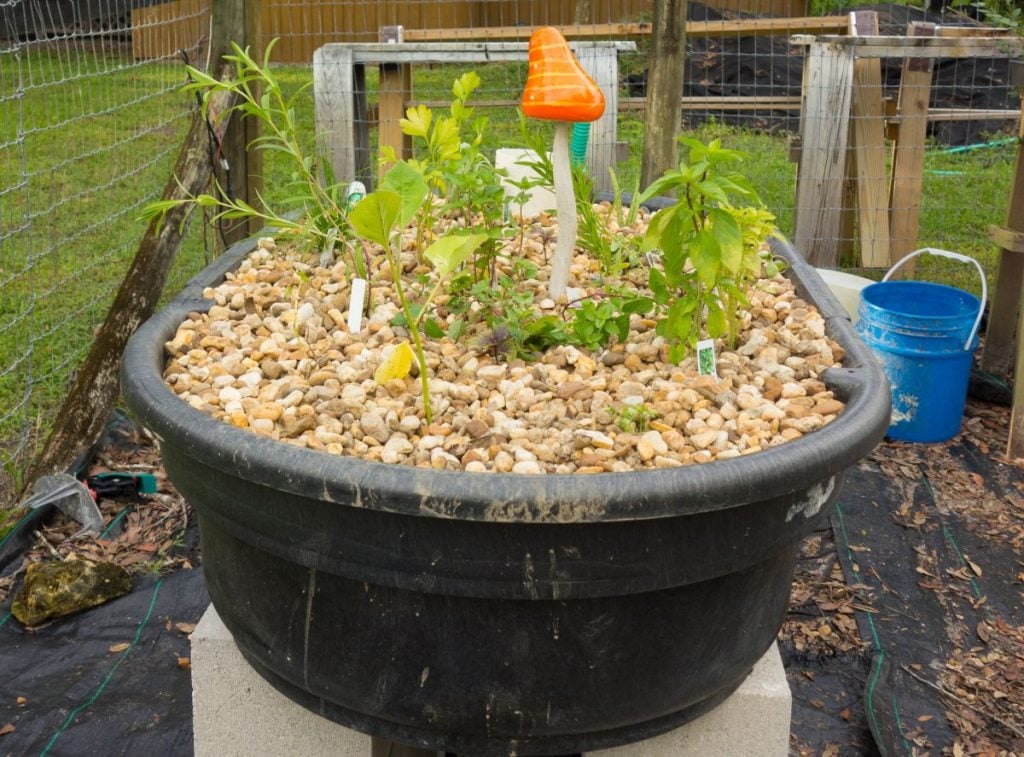
Step 4: Fit the components
You will need a pump, piping and plumbing fittings to get the water from your fish tank to the grow bed and back again.
Place the pump at the bottom of the fish tank to pump water up to the high end of the growing bed. Using a T-fitting with a cross pipe the width of the grow bed at the end of the pump hose is a good idea.
Make holes in the cross pipe to distribute the water evenly across the width of the grow bed.
You can use a timer to switch the pump on and off and control how much water goes into the grow beds. How often you flood the bed depends on the requirements of the plants you are growing.
Step 5: Test your aquaponics system.
Once you have installed all the components, it is time to test the system.
Fill the tank with pond or rainwater. If you use tap water, you will need to leave it for at least two weeks before adding any fish to allow time for natural bacteria to build up.
Then switch on the pump and circulate the water checking all your piping and joints for leaks. The water should be pumped up to the grow bed, travel through the bed, and drain back into the tank.
Step 6: Add the fish
Now that your system is set up and tested, you can add your fish.
A well-balanced aquaponics system can support a pound (0.45kg) of fish per gallon (3.78 liters) of water.
However, when starting, use one fish for every 10 gallons (37.8 liters) of water, giving the fish space and ensuring the system does not fall out of balance. You can always add more fish later.
Make sure your water suits the requirements of the fish you have chosen, and add your fingerlings.
It will take a while for your fingerlings to grow and produce enough waste to support plants.
During this time, the water needs to circulate through the grow beds as the growing medium will filter the water whether plants are growing or not.

Step 7: Add the plants
Using seedlings is an effective way to add plants to your growing bed as they have a head start. Remember to choose plants that suit your system’s capabilities in terms of size and nutrient production.
It is a good idea to plant seeds in trays of potting soil when you introduce the fingerlings to your tank. By the time the seedlings are ready to transplant, your fish should be producing enough waste to support them.
When transplanting your seedlings from the soil, carefully rinse the dirt off the roots in a container of water before placing the plants gently into the growing medium, ensuring they are far enough down to reach the water and get nutrients.
Seedlings are not the only way to add plants to your aquaponics system.
You can also sow some seeds directly in your grow beds, use starter plugs and even grow plants and herbs like basil and mint from cuttings.
Step 8: Maintain your system
Maintaining an aquaponics system is relatively simple. Feeding the fish is the most time-consuming aspect, and you can program automatic feeders to do this for you.
Overfeeding the fish is one of the most common mistakes, so only feed your fish as much as they can eat in around five to ten minutes, two to three times per day.
Every week or two, you’ll need to test the tank water. Check the pH, ammonia, nitrites and nitrate levels and make any necessary adjustments.
The Pros and Cons of Aquaponics
Aquaponics is growing in popularity, especially in urban areas, but like many other growing techniques, it has pros and cons.
Pros of aquaponics
Aquaponics is considered a sustainable growing system with several benefits for the environment. Here are some of the pros of aquaponics:
- Environmentally friendly
- Uses organic fertilization
- Saves water
- Efficient nutrient utilization
- Affordable
- Easy to maintain
- Space efficient
- Close to markets
- Source of income
- High yield
- No soil is required
Cons of aquaponics
Although aquaponics has many pros, there are a few cons to take into consideration:
- A limited selection of crops
- Initial setup cost
- High electricity consumption
- Multiple potential failure points
- Unsustainable fish food
- Requires ongoing attention
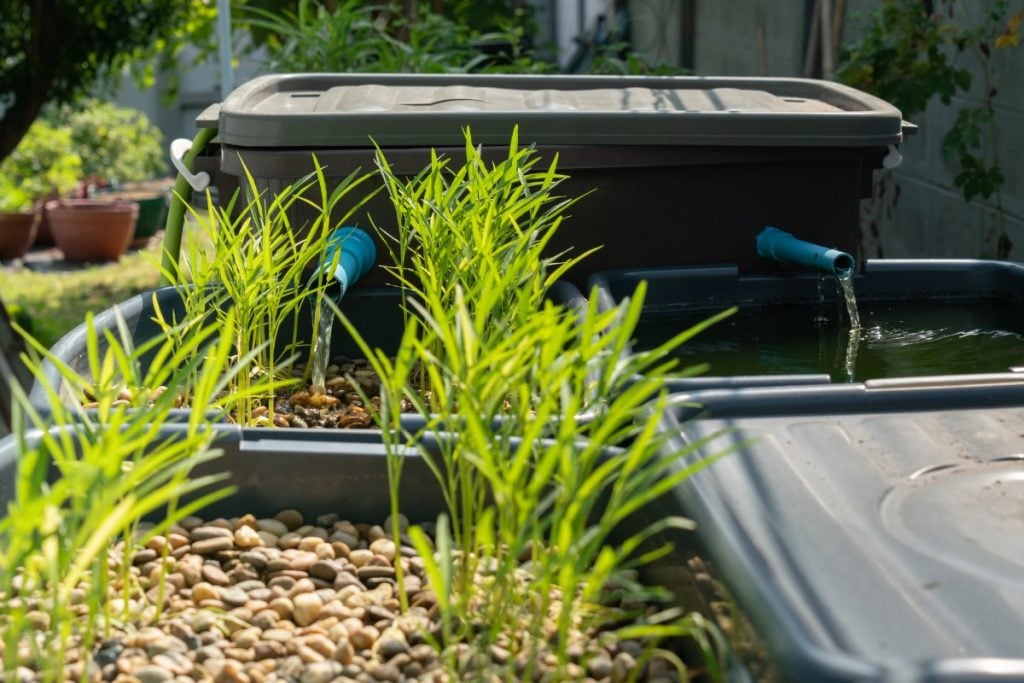
Can You Make Money With Aquaponics?
Yes, you can make money with aquaponics, but you need to work hard, apply yourself and behave like a business person as well as a farmer.
Growing the plants is the easy part. You’ll need a plan to make people aware of your brand and product and a unique selling point that sets you apart from your competitors.
People need food. It is one of the basic human needs. If you apply business principles, have an exceptional work ethic and put maximum effort into selling your product, there is potential to make plenty of money.
Tips for making money with aquaponics
Here are a few tips and ideas to help you make money with your aquaponics system.
- Get to know the local market in your area and find what types of vegetables and herbs are popular.
- Focus on profitable crops that are not readily available in the current market.
- Start a market garden using your aquaponics system.
- Consider growing off-season crops indoors or in a greenhouse.
- Use your aquaponics system to start a microgreens business.
- Sell to local businesses rather than direct customers. This is often more convenient and predictable, allowing you to plan production.
- Use fish and vegetables that you can easily sustain in your local climate without additional expense.
- Start small but allow room for expansion as you learn the ins and outs of your market and gain new customers.
Final Thoughts
Aquaponics growing systems are an easy, fun and scalable way to grow fresh produce for your family and earn additional income.
You can set up your DIY aquaponics system in a matter of hours and in as little as two weeks be enjoying fresh homegrown microgreens and leafy vegetables.
As a bonus, aquaponics growing techniques are also environmentally friendly. And can be used as part of a permaculture design.
Visit our Permaculture Resource Hub to find out more about permaculture and other growing techniques.
